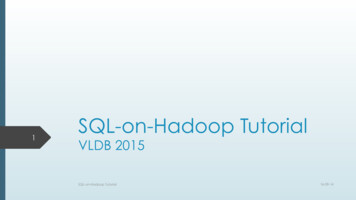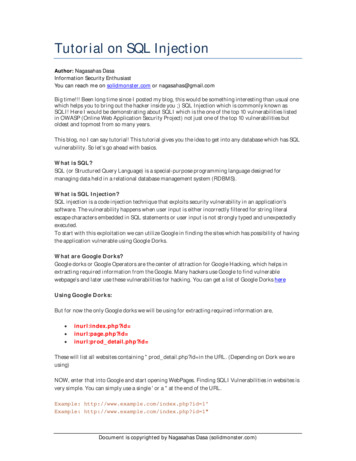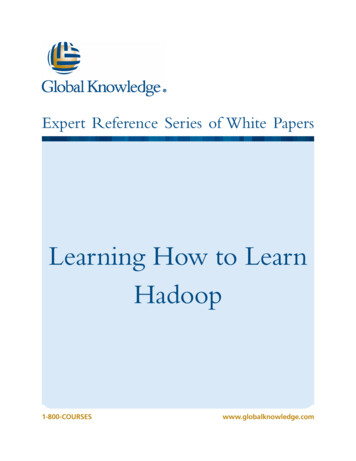
Transcription
1SQL-on-Hadoop TutorialVLDB 2015SQL-on-Hadoop Tutorial16-09-14
Presenters2Fatma ÖzcanIBM ResearchDaniel AbadiYale University andTeradataIBM Big SQLSQL-on-Hadoop TutorialHadoopDB/HadaptIppokratis PandisClouderaShivnath BabuDuke UniversityCloudera ImpalaStarfish16-09-14
3Why SQL-on-Hadoop? People need to process data in parallel Hadoop is by far the leading open source parallel dataprocessing platform Low costs of HDFS results in heavy usageLots of data in Hadoop with appetite to process itSQL-on-Hadoop Tutorial16-09-14
MapReduce is not the answer4 MapReduce is a powerful primitive to do many kinds ofparallel data processing BUT Little control of data flow Fault tolerance guarantees not always necessary Simplicity leads to inefficiencies Does not interface with existing analysis software Industry has existing training in SQLSQL interface for Hadoop critical for mass adoptionSQL-on-Hadoop Tutorial16-09-14
5The database community knows howto process data Decades of research in parallel database systems Efficient data flow Load balancing in the face of skew Query optimization Vectorized processing Dynamic compilation of query operators Co-processing of queriesMassive talent war between SQL-on-Hadoopcompanies for members of database communitySQL-on-Hadoop Tutorial16-09-14
6SQL-on-Hadoop is not a directimplementation of parallel DBMSs Little control of storage Most deployments must be over HDFS Append-only file system Must support many different storage formats Avro, Parquet, RCFiles, ORC, Sequence Files Little control of metadata management Optimizer may have limited access to statistics Little control of resource management YARN still in its infancySQL-on-Hadoop Tutorial16-09-14
7SQL-on-Hadoop is not a directimplementation of parallel DBMSs Hadoop often used a data dump (swamp?) Data often unclean, irregular, and unreliable Data not necessarily relational HDFS does not enforce structure in the data Nested data stored as JSON extremely popular Scale larger than previous generation parallel databasesystems Fault tolerance vs. query performance Most Hadoop components written in Java Want to play nicely with the entire Hadoop ecosystemSQL-on-Hadoop Tutorial16-09-14
Outline of Tutorial8 This session [13:30-15:00] SQL-on-Hadoop Technologies Second Session [15:30-17:00] SQL-on-Hadoop examples Storage HadoopDB/Hadapt Run-time engine Presto Query optimization Impala Q&A BigSQL SparkSQL Phoenix/Spice Machine Research directionsSQL-on-Hadoop Tutorial Q&A16-09-14
9StorageSQL-on-Hadoop Tutorial16-09-14
10Quick Look at HDFSNameNodeDataNodeSQL-on-Hadoop TutorialDataNode DataNode16-09-14
11HDFS is Good for Storing large files Write once and read many times “Cheap” commodity hardware Not good for Low-latency reads Short-circuit reads and HDFS caching help Large amounts of small files Multiple writersSQL-on-Hadoop Tutorial16-09-14
12In-situ Data Processing HDFS as the data dump Store the data first, figure out what to do later Most data arrive in text format Transform, cleanse the data Create data marts in columnar formats Lost of nested, JSON data Some SQL in data transformations, but mostly otherlanguages, such as Pig, Cascading, etc. Columnar formats are good for analyticsSQL-on-Hadoop Tutorial16-09-14
13SQL-on-Hadoop according to storage formats Most SQL-on-Hadoop systems do not control or own the data Hive, Impala, Presto, Big SQL, Spark SQL, Drill Other SQL-on-Hadoop systems tolerate HDFS data, but workbetter with their own proprietary storage HadoopDB/Hadapt HAWQ, Actian Vortex, and HP VerticaSQL-on-Hadoop Tutorial16-09-14
14Query Processors with HDFS Native Formats Only support native Hadoop formats with opensource reader/writers Any Hadoop tool can generate their data Pig, Cascading and other ETL tools They are more of a query processor than a database Indexing is a challenge !! No co-location of multiple tables Due to HDFSSQL-on-Hadoop Tutorial16-09-14
15Systems with Proprietary Formats Almost all exploit some existing database systems They store their own binary format on HDFS Hadapt stores the data in a single node database,like postgres Can exploit Postgres indexes HAWQ, Actian, HP Vertica, and Hadapt all controlhow tables are partitioned, and can support colocated joinsSQL-on-Hadoop Tutorial16-09-14
16HDFS Native Formats CSV files are most common for ETL-like workloads Lots of nested and complex data Arrays, structs, maps, collections Two major columnar formats ORCFile Parquet Data serialization JSON and Avro Protocol buffers and ThriftSQL-on-Hadoop Tutorial16-09-14
17Parquet§ PAX format, supporting nested data§ Idea came from the Google‘s Dremel System§ Major contributors: Twitter & Cloudera§ Provides dictionary encoding and several compressions§ Preffered format for Impala, IBM Big SQL, and Drill§ Can use Thrift or Avro to describe the schemaColumnar storageNested data§ Fast compression§ Schema projection§ Efficient encoding§ A natural schema§ Flexible§ Less duplication applyingdenormalizationSQL-on-Hadoop Tutorial1716-09-14
18Parquet, cont. A table with N columns is splitinto M row groups. The file metadata containsthe locations of all thecolumn metadata startlocations. Metadata is written after thedata to allow for single passwriting. There are three types ofmetadata: file metadata,column (chunk) metadataand page header metadata. Row group metadataincludes Min-max values for skippingSQL-on-Hadoop Tutorial16-09-14
19ORCFile Second generation, following RC file PAX formats with all data in a single file Hortonworks is the major contributor, together with Microsoft Preferred format for Hive, and Presto Supports Dictionary encoding Fast compression File, and stripe level metadata Stripe indexing for skipping Now metadata even includes bloom filters for point query lookupsSQL-on-Hadoop Tutorial16-09-14
20ORCFile LayoutSQL-on-Hadoop Tutorial16-09-14
21Handling Updates in HDFS No updates in HDFS Appends to HDFS files are supported,but not clear how much they areused in productiondelta1 Updates are collected in delta filesdelta2 At the time of read delta and mainfiles are merged Special inputFormats Lazy compaction to merge deltafiles and main files When delta files reach a certain sizeFile A deltan Scheduled intervalsSQL-on-Hadoop Tutorial16-09-14
22SQL on NoSQL! Put a NoSQL solution on top of HDFS For the record, you can avoid HDFS completely But, this is a SQL-on-Hadoop tutorial NoSQL solutions can provide CRUD at scale CRUD Create, Read, Update, Delete And, then run SQL on it? Sounds crazy? Well, lets seeSQL-on-Hadoop Tutorial16-09-14
23HBase: The Hadoop Database Not HadoopDB, which we will see later in the tutorial HBase is a data store built on top of HDFS based on Google Bigtable Data is logically organized into tables, rows, and columns Although, Key-Value storage principles are used at multiple points in the design Columns are organized into Column Families (CF) Supports record-level CRUD, record-level lookup, random updates Supports latency-sensitive operations
24HBase Architecture
25HBase ArchitectureHBase stores three types of fileson HDFS: WALs HFiles Links
26HBase Read and Write Paths
27HFile FormatHFile Structure Immutable Created on flush or compaction Sequential writes Read randomly or sequentially Data is in blocks HFile blocks are not HDFS blocks Default data block size 64K Default index block size 128K Default bloom filter block size 128K Use smaller block sizes forfaster random lookup Use larger block sizes for faster scans Compression is recommended Block encoding is recommended
28Run-time EngineSQL-on-Hadoop Tutorial16-09-14
29Design Decisions: Influencers Low Latency High Throughput Degree of tolerance to faults Scalability in data size Scalability in cluster size Resource elasticity Multi-tenancy Ease of installation in existing environmentsSQL-on-Hadoop Tutorial16-09-14
30Accepted across SQL-on-Hadoop Solutions Push computation to data Columnar data formats Vectorization Support for multiple data formats Support for UDFsSQL-on-Hadoop Tutorial16-09-14
31Differences across SQL-on-Hadoop Solutions What is the Lowest Common Execution Unit Use of Push Vs. Pull On the JVM or not Fault tolerance: Intra-query or inter-query Support for multi-tenancySQL-on-Hadoop Tutorial16-09-14
32SQL on MapReduce Hive TenzingSQL-on-Hadoop Tutorial16-09-14
33HiveSQL-on-Hadoop Tutorial16-09-14
34Example: Joins in MapReduceSQL-on-Hadoop Tutorial16-09-14
35Limitations Having a MapReduce Job as the Lowest Execution Unitquickly becomes restrictive Query execution plans become MapReduce workflowsSQL-on-Hadoop Tutorial16-09-14
MapReduce Workflows36D01D02J2J1DatasetsMapReduce JobsD2D1J3D3J4D4J5D5D6J7D7J6
37Research Done to Address these Limitations On efficient joins in the MapReduce paradigm On reducing the number of MapReduce jobs bypacking/collapsing the MapReduce workflow Horizontally Shared scans Vertically Making using of static and dynamic partitioning On efficient management of intermediate dataSQL-on-Hadoop Tutorial16-09-14
38From MapReduce to DAGs Dryad TezSQL-on-Hadoop Tutorial16-09-14
39Dryad: Dataflows as First-class CitizensSQL-on-Hadoop Tutorial16-09-14
40Smart DAG Execution in DryadSQL-on-Hadoop Tutorial16-09-14
41Tez: Inspired by Dryad and Powered by YARNSQL-on-Hadoop Tutorial16-09-14
42Quick Detour on YARN The Hadoop Community realized thatMapReduce cannot be the LowestExecution Unit for all data apps Separated out the resourcemanagement aspects fromapplication management YARN is best seen as an OperatingSystem for Data Processing Apps Recall the 80s: Databases andOperating Systems: Friends or Foes?SQL-on-Hadoop Tutorial16-09-14
43An Example of What Tez EnablesSQL-on-Hadoop Tutorial16-09-14
44A Tez Slide on TezSQL-on-Hadoop Tutorial16-09-14
Spark: A Different Way to Look at a aveAsTextFile
Spark: A Different Way to Look at a DataflowStage ).saveAsTextFile(outPath)Stage lterreduceBykeymap saveAsTextFile
Spark: A Different Way to Look at a DataflowStage ).saveAsTextFile(outPath)Stage pfilterreduceBykeysaveAsTextFile
Spark: A Different Way to Look at a rt1part1part1part1part1part1Exec2Stage 1part2part2part2part2part2part2Exec3Stage apsaveAsTextFile
49Spark: A Different Way to Look at a DataflowSQL-on-Hadoop Tutorial16-09-14
50Fault ToleranceSQL-on-Hadoop Tutorial16-09-14
51MapReduce Fault apSQL-on-Hadoop e16-09-14
52MapReduce Fault apSQL-on-Hadoop e16-09-14
53MapReduce Fault apSQL-on-Hadoop e16-09-14
54MapReduce Fault apSQL-on-Hadoop e16-09-14
55MapReduce Fault apSQL-on-Hadoop e16-09-14
56MapReduce Fault apSQL-on-Hadoop e16-09-14
Fault TolerancePercentage Slowdown57200180160140120100806040200 SELECT sourceIP,SUM(adRevenue)FROM UserVisitsGROUP BY sourceIPTraditionalDBMSMapReduce Node fails (or slows downby factor of 2) in themiddle of queryFault toleranceSQL-on-Hadoop TutorialSlowdown tolerance16-09-14
58Downsides of MapReduce FaultToleranceMapMap outputwritten to diskReduce outputwritten to -Hadoop e16-09-14
59Spark RDDs Stores intermediate results in memory rather than disk Advantage: Performance Disadvantage: Memory requirementsSQL-on-Hadoop Tutorial16-09-14
60Resource ManagementSQL-on-Hadoop Tutorial16-09-14
61Resource Management (At least) Two dimension problem:1. RM across different frameworks Usually not a dedicated cluster Shared across multiple frameworks ETL (MapReduce, Spark), Hbase SQL-on-Hadoop processing2. RM across concurrent queriesSQL-on-Hadoop Tutorial16-09-14
62RM -- Across frameworks YARN – Yet Another Resource Negotiator Centralized, cluster-wide resource managementsystem Allows frameworks to share resources withoutpartitioning between them Designed for batch-mostly processing Not mature Not good for interactive analytics Not meant for long running processes Approaches: Llama and SliderSQL-on-Hadoop Tutorial16-09-14
RM -- LLAMA (low-latency application master) Introduced by Cloudera LLAMA acts as a proxy between Impala and YARN Mitigates some of the batch-centric design aspects ofYARN: High resource acquisition latency - solves via resource caching Resource request is immutable - solves via expansion request Resource allocation is incremental - solves via gang scheduling63
64RM -- Apache Slider Slider allows running non-YARN enabled applications on YARN Without having to write your own custom Application Master Existing applications are packaged as Slider applications Encapsulates a set of one or more application components or roles Deployed by Slider, runs in containers across a YARN cluster Pre-built packages for HBase, Accumulo, Storm, andjmemcached Packages need to be custom built for other applications Some notable Slider features Applications can be stopped and started later à state is persisted Container failures are automatically detected by Slider andrestarted64
65Query OptimizationSQL-on-Hadoop Tutorial16-09-14
66Some Techniques We Know and LoveAre not Directly Applicable Indexing Zone-maps Co-located joins Query rewrites Cost-basedoptimizationSQL-on-Hadoop Tutorial Databases own their storageSQL-on-Hadoop systems donot Metadata management istricky Data inserted/loaded withoutSQL system knowledge No co-location of relatedtables HDFS is for most practicalpurposes, read-only16-09-14
67I/O Elimination for HDFS Data: Partition-level Hive Partition tables maintain metadata values as one folder/directory in HDFS, per distinct value: Example: PARTITIONED BY (country STRING, year INT, month INT, day INT) ; Folder/Directory created for country US/year 2012/month 12/day 22 Partitioning only logical, not physical Partition pruning eliminates reading files that are not needed Almost all SQL-on-Hadoop offerings support this Hive, Impala, SparkSQL, IBM BigSQL, .SQL-on-Hadoop Tutorial16-09-14
68I/O Elimination for HDFS Data: Rowblock-level ORCFile broken into Stripes (250MB default) Index with Min/Max values stored for each Column Data is a “stream” of columns Bloom filters for each stripe in ORCFile allow fast lookups Parquet also supports min/max values Works well when data is sorted, not very effective otherwiseSQL-on-Hadoop Tutorial16-09-14
69Quick look at query optimizers Two types of optimization Logical transformations to transform query into equivalent but simpler form Cost-based enumeration of alternative execution plans Most systems support the first one Cost-based optimization depends on good statistics and a goodmodel of the execution environment Without controlling data storage, statistics are “gestimates”SQL-on-Hadoop Tutorial16-09-14
70Query Rewrite Selection/projection pushdown Nested SQL queries require more sophisticated rewrites,such as decorrelation New systems all have rewrites but lack complexdecorrelation and subquery optimization ones Hive, Impala, Presto, Spark SQL Systems that leverage mature DB technology offer moresophisticated rewrite engines IBM SQL, Hadapt, HP VerticaSQL-on-Hadoop Tutorial16-09-14
71Cost-based Optimization Hive analyze table collects basic statistics Column value distributions, min-max, no-of-distinct values No control of data à data changes without the systems’knowledge Multi-tenant system makes it harder to build a costmodel More complex system behaviorMore adaptive query processing is neededSQL-on-Hadoop Tutorial16-09-14
72Co-located joins Co-partitioning two tables on the join key enables local joinsFile AFile BFile CFile DØ Files A & B are co-locatedØ Files C & D are co-located HDFS default block placement policy scatters blocks in thecluster Actian Vortex changes HDFS default block placement toenforce co-located joinsSQL-on-Hadoop Tutorial16-09-14
Outline of Tutorial73 This session [13:30-15:00] SQL-on-Hadoop Technologies Second Session [15:30-17:00] SQL-on-Hadoop examples Storage HadoopDB/Hadapt Run-time engine Presto Query optimization Impala Q&A BigSQL SparkSQL Phoenix/Spice Machine Research directionsSQL-on-Hadoop Tutorial Q&A16-09-14
74HadoopDB First of avalanche of SQL-on-Hadoop solutions to claim 100x faster than Hive (oncertain types of queries) Used Hadoop MapReduce to coordinate execution of multiple independent(typically single node, open source) database systems Maintained MapReduce’s fault tolerance Sped up single-node processing via leveraging database performance optimizations: Compression Vectorization Partitioning Column-orientation Query optimization Broadcast joins Flexible query interface (both SQL and MapReduce)
75HadoopDB Architecture
76HadoopDB SMS Planner
77HadoopDB History Paper published in 2009 Company founded in 2010 (Hadapt) to commercializeHadoopDB Added support for search in 2011 (for major insurancecustomer) Added JSON support in 2012 Added interactive query engine in 2013 Acquired by Teradata in 2014SQL-on-Hadoop Tutorial16-09-14
Teradata Unified Data Architecture: omers& istsEngineers &ProgrammersTERADATA OR ASTER DATABASETERADATA QUERYGRIDPUSH DOWN / REMOTE PROCESSINGSQL-HSQLSQLSQL, NOSQLVARIOUSDATA PLATFORMINTEGRATED ECLUSTERSHADOOP ODB, ETCSAS, PYTHON,R, PERL, RUBY
Remote Processing On Hadoop Query throughTeradata Leaves of query plansent to SQL-on-Hadoopengine Results returned toTeradata Additional queryprocessing done inTeradata Final results sent backto applicatio
Only support native Hadoop formats with open-source reader/writers ! Any Hadoop tool can generate their data !Pig, Cascading and other ETL tools ! They are more of a query processor than a database ! Indexing is a challenge !! ! No co-location of multiple tabl









![Unreal Engine 4 Tutorial Blueprint Tutorial [1] Basic .](/img/5/ue4-blueprints-tutorial-2018.jpg)

